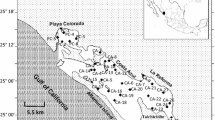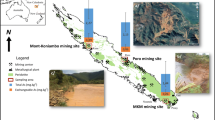Abstract
The geochemical mobility of arsenic and some metals in the fine fraction of 20 alluvial sediment samples collected along the thalweg of the San Antonio arroyo was assessed in the abandoned gold mining district of the semi-arid southeastern Baja California peninsula. Acid-digested element concentrations were determined by treating the fine fraction of the sediments with concentrated HNO3 via microwave heating. A separate leaching of the diluted acid-soluble As and some metals from the samples was carried out using 1 M HCl. The most reactive As phase was extracted from the subsamples using an ascorbic solution of Na citrate buffered at pH 8. The high abundance of sulphosalts (tennantite Cu12As4S13 and proustite Ag3AsS3) in the sediments from the head of the arroyo changes downstream to the predominance of arsenic trioxide (arsenolite As2O3) and arsenate (scorodite FeAsO4·2H2O). Acid-digested As concentrations were always found to be high (230–270 mg kg−1) from the San Antonio village until the end of the arroyo. The concentration of reactive As and its relative contribution increased from low values of 2.3 mg kg−1 and 1 %, respectively, at the upstream of the arroyo, to 191–220 mg kg−1 and 75–89 % in the middle and lower parts, and is probably a result of As release from the mineral sulfide fraction of the tailings. Metallic contaminants exhibited different behavior, with a peak of acid-digested and diluted acid-leached concentrations observed in the central part of the arroyo and an almost permanent geochemical mobility.





Similar content being viewed by others
References
Acero R, Ayora C, Torrentó C, Nieto J-M (2006) The behaviour of trace elements during schwertmanite precipitation and subsequent transformation into goethite and jarosite. Geochim Cosmochim Acta 70:4130–4139
Adriano DC (1986) Trace elements in the terrestrial environment. Springer, New York
Anonymous (1999) Monografía geológico-minera del estado de Baja California Sur. Consejo de Recursos Minerales, Pachuca (in Spanish)
Armienta MA, Villaseñor G, Cruz O, Ceniceros N, Aguayo A, Morton O (2012) Geochemical processes and mobilization of toxic metals and metalloids in an As-rich base metal waste pile in Zimapán, Central México. Appl Geochem 27:2225–2237
Bird G, Brewer PA, Macklin MG, Balteanu D, Driga B, Serban M, Zaharia S (2003) The solid state partitioning of contaminant metals and As in river channel sediments of the mining affected Tisa Drainage basin, northwestern Romania and eastern Hungary. Appl Geochem 18:1583–1595
Black F, Paytan A, Knee K, de Sieyes N, Ganguli P, Gray E, Flegal AR (2009) Submarine groundwater discharge of total mercury and monomethyl mercury to central California coastal waters. Environ Sci Technol 43:5652–5659
Boughriet A, Proix N, Billon G, Recourt P, Ouddane B (2007) Environmental impacts of heavy metal discharges from a smelter in Deûle-canal sediments (North France): concentration levels and chemical fractionation. Water Air Soil Pollut 180:83–95
Carrillo A (1996) Environmental geochemistry of the San Antonio-El Triunfo mining area, southernmost Baja California Peninsula Mexico. Dissertation, University of Wyoming
Carrillo A, Drever JI (1998) Environmental assessment of the potential for arsenic leaching into groundwater from mine wastes in Baja California Sur, Mexico. Geofís Internacional 37:35–39
Carrillo-Chávez A, Drever J, Martínez M (2000) Arsenic content and groundwater geochemistry of the San Antonio-El Triunfo, Carrizal and Los Planes aquifers in southernmost Baja California, Mexico. Environ Geol 39:1295–1303
Cassassuce F, Armenta J, Loera E, Olvera J (2004) Estudio de 500 pozos en Baja California Sur. Informe de Niparaja-Conagua, La Paz, Baja California Sur (in Spanish)
Chaillou G, Schäfer J, Anschutz P, Lavaux G, Blanc G (2003) The behaviour of arsenic in muddy sediments of the Bay of Biscay (France). Geochim Cosmochim Acta 67:2993–3003
Colín-Torres CG, Murillo-Jiménez JM, Del Razo LM, Sánchez-Peña LC, Becerra-Rueda OF, Marmolejo- Rodríguez AJ (2014) Urinary arsenic levels influenced by abandoned mine tailings in the Southernmost Baja California Peninsula, Mexico. Environ Geochem Health 36:845–854
EPA (2012) Method–3051. www.caslab.com/EPA-Method-3051/. Accessed on 21 March 2014
Escandón FJ (1983) Análisis de los trabajos geológicos mineros efectuados en el distrito de El Triunfo-San Antonio, Baja California Sur y evaluación económica preliminar. Unpublished report. Consejo de Recursos Minerales (in Spanish)
Förstner U, Wittmann GTW (1976) Metal accumulations in acidic waters from gold mines in South Africa. Geoforum 7:41–49
García-Lorenzo ML, Pérez-Sirvent C, Martínez-Sánchez MJ, Molina-Ruiz J (2012) Trace element contamination in an abandoned mining site in a semiarid zone. J Geochem Explor 113:23–35
Garelick H, Jones H, Dybovska A, Valsami-Jones E (2008) Arsenic pollution sources. Rev Environ Contam Toxicol 197:17–60
Gräfe M, Sparks DL (2005) Kinetics of zinc and arsenate-co-sorption at the goethite-water interface. Geochim Cosmochim Acta 69:4573–4595
Haffert L, Craw D (2010) Geochemical processes influencing arsenic mobility at Bullendale historic gold mine, Otago, New Zealand. New Zealand J Geol Geophys 53:129–142
Hayes SM, Webb SM, Bargar JR, O'Day PA, Maier RM, Chorover J (2012) Geochemical weathering increases lead bioaccessibility in semi-arid mine tailings. Environ Sci Technol 46:5834–5841
Hutchinson TC, Aufreiter S, Hancock RGV (1982) Arsenic pollution in the Yellowknife area from gold smelter activities. J Radioanalyt Chem 71:59–73
Hyacinthe C, Anschutz P, Jouanneau J-M, Jorissen FJ (2001) Early diagenesis processes in the muddy sediment of the Bay of Biscay. Mar Geol 177:111–128
Keon NE, Swartz CH, Harvey C, Hemond HF (2001) Validation of an arsenic sequential extraction method for evaluating mobility in sediments. Environ Sci Technol 35:2778–2784
Kostka JE, Luther GW (1994) Portioning and speciation of solid phase iron in saltmarsh sediments. Geochim Cosmochim Acta 58:1701–1710
Litter M, Morgada ME, Bundschuh J (2010) Possible treatments for arsenic removal in Latin American waters for human consumption. Environ Pollut 158:1105–1118
Long ER, Macdonald DD, Smith SL, Calder FD (1995) Incidence of adverse biological effects within ranges of chemical concentrations in marine and estuarine sediments. Environ Manag 19:81–97
López-Gónzalez N, Borrego J, Morales JA, Carro B, Lozano-Soria O (2006) Metal fractionation in oxic sediments of an estuary affected by acid mine drainage (south-western Spain). Estuar Coast Shelf Sci 68:297–304
Mandal BK, Suzuki KT (2002) Arsenic round the world: a review. Talanta 58:201–235
Marmolejo-Rodríguez AJ, Sánchez-Martínez MA, Romero-Guadarrama JA, Sánchez- González A, Magallanez-Ordóñez VR (2011) Migration of As, Hg, Pb and Zn in arroyo sediments from a semi-arid system influenced by the abandoned gold mining district at El Triunfo, Baja California Sur, Mexico. J Environ Monit 13:2182–2189
Naranjo-Pulido A, Romero-Schmidt H, Méndez-Rodríguez L, Acosta-Vargas B, Ortega-Rubio A (2002) Soil arsenic contamination in the Cape Region, B.C.S., Mexico. J Environ Biol 23:347–352
Navarro-Flores A, Doménech-Rubio L (2010) Arsenic and metal mobility from Au mine tailings in Rodalquilar (Almería SE Spain). Environ Earth Sci 60:121–138
Navarro A, Collado D, Carbonell M, Sanchez JA (2004) Impact of mining activities on soil in a semi-arid environment: Sierra Almagera district, SE Spain. Environ Geochem Health 26:383–393
Ongley LK, Sherman L, Armienta A, Concilio A, Fergusson Salinas C (2007) Arsenic in the soils of Zimapán, Mexico. Environ Pollut 145:793–799
Posada Ayala IH (2011) Geoquímica ambiental del distrito minero San Antonio, sedimentos de los arroyos de la cuenca de San Juan de Los Planes y plataforma continental de Bahía La Ventana, B.C.S., México. Dissertation, Centro Interdisciplinario de Ciencias Marinas- IPN, La Paz, Baja California Sur, México, (in Spanish)
Razo I, Carrizales L, Castro J, Díaz-Barriga F, Monroy M (2004) Arsenic and other heavy metal pollution of soil, water and sediments in a semi-arid climate mining area in Mexico. Water Air Soil Pollut 152:129–152
Reith F, McPhail DC (2007) Mobility and microbially mediated mobilization of gold and arsenic in soils from two gold mines in semi-arid and tropical Australia. Geochim Cosmochim Acta 71:1183–1196
Sánchez-Martínez M, Marmolejo-Rodríguez AJ, Magallanez-Ordóñez VR, Sánchez-González A (2013) Vertical accumulation of potential toxic elements in the semi-arid system that is influenced by an abandoned gold mine. Estuar Coast Shelf Sci 130:42–53
Savage KS, Tingle TN, O´Day PA, Wayuchunas A, Bird DK (2000) Arsenic speciation in pyrite and secondary weathering phases, Mother Lode Gold District, Tuolumne County, California. Appl Geochem 15:1219–1244
Shulkin VM (1998) Pollution of the coastal bottom sediments at the Middle Primorie (Russia) due to mining activity. Environ Pollut 101:401–404
Smedley PL, Kinniburg DG (2002) A review of the source, behavior and distribution of arsenic in natural waters. Appl Geochem 17:517–568
Smedley PL, Edmunds WM, Peling-Ba KB (1996) Mobility of arsenic in groundwater in the Obuasi gold-mining area of Ghana: some implications for human health. Geol Soc Lond Special Publ 113:163–181. doi:10.1144/GSL.SP.1996.113.01.13
Thornton I (1996) Impact of mining on the environment; some local, regional and global issues. Appl Geochem 11:355–361
Torrance K, Keenan H, Mumk LA, Hagedorn B (2012) Arsenic speciation and mobility in surface water at Lucky Shot Gold Mine, Alaska. Environ Geochem Health 34:711–723
Villaescusa I, Bollinger J-C (2008) Arsenic in drinking water: sources, occurrence and health effects (a review). Rev Environ Sci Biotechnol 7:307–323
Volke Sepúlveda T, Solórzano Ochoa G, Rosas Domínguez A, Izumikawa C, Aguilar GE, Velasco Trejo JA, Flores Martínez S (2003) Remediación de sitios contaminados por metales provenientes de jales mineros en los distritos de El Triunfo-San Antonio y Santa Rosalía, B.C.S. Delegación de Investigación en Residuos y Proyectos Regionales. Centro Nacional de Investigación y Capacitación Ambiental. Instituto Nacional de Ecología CENICA- INE- SEMARNAT. Informe final (in Spanish)
Walker SR, Parsons MB, Jamieson HE, Lanzirotti A (2009) Arsenic mineralogy of near-surface tailing and soils: influences on arsenic mobility and bioaccessibility in the Nova Scotia gold mining districts. Can Mineral 47:533–556
Wedepohl KH (1995) The composition of the continental crust. Geochim Cosmochim Acta 59:1217–1232
Wittmann G, Förstner U (1976) Heavy metal enrichment in mine drainage. II. Witwatersrand Goldfields. S Afr J Sci 72:365–370
Acknowledgments
The authors are thankful to the technical personnel of the Centro Interdisciplinario de Ciencias Marinas-Instituto Politécnico Nacional of Mexico for their assistance provided during sampling. This study was partly supported by the Brazilian National Research Council (CNPq).
Author information
Authors and Affiliations
Corresponding author
Rights and permissions
About this article
Cite this article
Shumilin, E., Mirlean, N., Choumiline, K. et al. Increasing arsenic mobility in the fine fraction of the dry stream sediments of the semi-arid San Antonio gold mining district (Baja California peninsula, Mexico). Environ Earth Sci 73, 4689–4700 (2015). https://doi.org/10.1007/s12665-014-3753-0
Received:
Accepted:
Published:
Issue Date:
DOI: https://doi.org/10.1007/s12665-014-3753-0




